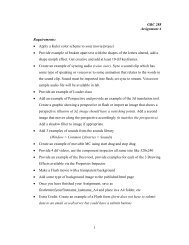Introducing Financial Accounting - CCSN Computer Graphics Program
Introducing Financial Accounting - CCSN Computer Graphics Program
Introducing Financial Accounting - CCSN Computer Graphics Program
You also want an ePaper? Increase the reach of your titles
YUMPU automatically turns print PDFs into web optimized ePapers that Google loves.
wiL27041_ch01_002-047.indd Page 31 10/4/10 7:12:53 PM user-f499 /Volumes/204/MHBR211/wiL27041_disk1of1/0073527041/wiL27041_pagefiles<br />
Chapter 1 <strong>Introducing</strong> <strong>Financial</strong> <strong>Accounting</strong> 31<br />
An important responsibility of many accounting professionals is to design and implement internal control<br />
procedures for organizations. Explain the purpose of internal control procedures. Provide two examples of<br />
internal controls applied by companies.<br />
Identify the following users as either external users (E) or internal users (I).<br />
a. Lenders d. Sales staff g. Brokers j. Managers<br />
b. Controllers e. FBI and IRS h. Suppliers k. Business press<br />
c. Shareholders f. Consumer group i. Customers l. District attorney<br />
There are many job opportunities for those with accounting knowledge. Identify at least three main areas<br />
of opportunities for accounting professionals. For each area, identify at least three job possibilities linked<br />
to accounting.<br />
<strong>Accounting</strong> professionals must sometimes choose between two or more acceptable methods of<br />
accounting for business transactions and events. Explain why these situations can involve difficult<br />
matters of ethical concern.<br />
Identify which accounting principle or assumption best describes each of the following practices:<br />
a. If $51,000 cash is paid to buy land, the land is reported on the buyer’s balance sheet at $51,000.<br />
b. Alissa Kees owns both Sailing Passions and Dockside Supplies. In preparing financial statements for<br />
Dockside Supplies, Kees makes sure that the expense transactions of Sailing Passions are kept separate<br />
from Dockside’s transactions and financial statements.<br />
c. In December 2010, Ace Landscaping received a customer’s order and cash prepayment to install sod<br />
at a new house that would not be ready for installation until March 2011. Ace should record the revenue<br />
from the customer order in March 2011, not in December 2010.<br />
a. Total assets of Caldwell Company equal $40,000 and its equity is $10,000. What is the amount of its<br />
liabilities?<br />
b. Total assets of Waterworld equal $55,000 and its liabilities and equity amounts are equal to each other.<br />
What is the amount of its liabilities? What is the amount of its equity?<br />
Use the accounting equation to compute the missing financial statement amounts (a), (b), and (c).<br />
Company<br />
1<br />
2<br />
3<br />
Assets 5 Liabilities 1 Equity<br />
$ 30,000<br />
$ (a)<br />
$ 20,000<br />
(b)<br />
50,000<br />
30,000<br />
90,000<br />
10,000<br />
(c)<br />
<strong>Accounting</strong> provides information about an organization’s business transactions and events that both affect<br />
the accounting equation and can be reliably measured. Identify at least two examples of both (a) business<br />
transactions and (b) business events that meet these requirements.<br />
Use Apple’s September 26, 2009, financial statements, in Appendix A near the end of the book, to answer<br />
the following:<br />
a. Identify the dollar amounts of Apple’s 2009 (1) assets, (2) liabilities, and (3) equity.<br />
b. Using Apple’s amounts from part a, verify that Assets 5 Liabilities 1 Equity.<br />
QS 1-2<br />
Explaining internal control<br />
C1<br />
QS 1-3<br />
Identifying accounting users<br />
C2<br />
QS 1-4<br />
<strong>Accounting</strong> opportunities C2<br />
QS 1-5<br />
Identifying ethical concerns C3<br />
This icon highlights<br />
assignments that enhance<br />
decision-making skills.<br />
QS 1-6<br />
Identifying accounting<br />
principles<br />
C4<br />
QS 1-7<br />
Applying the accounting<br />
equation<br />
A1<br />
QS 1-8<br />
Applying the accounting<br />
equation<br />
A1<br />
QS 1-9<br />
Identifying transactions<br />
and events P1<br />
QS 1-10<br />
Identifying and computing<br />
assets, liabilities, and equity<br />
P1









